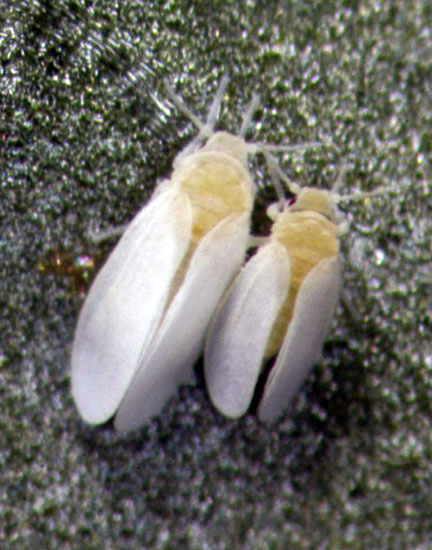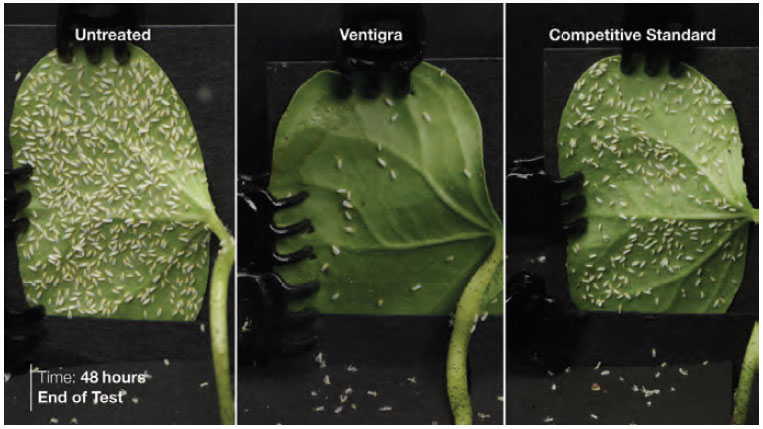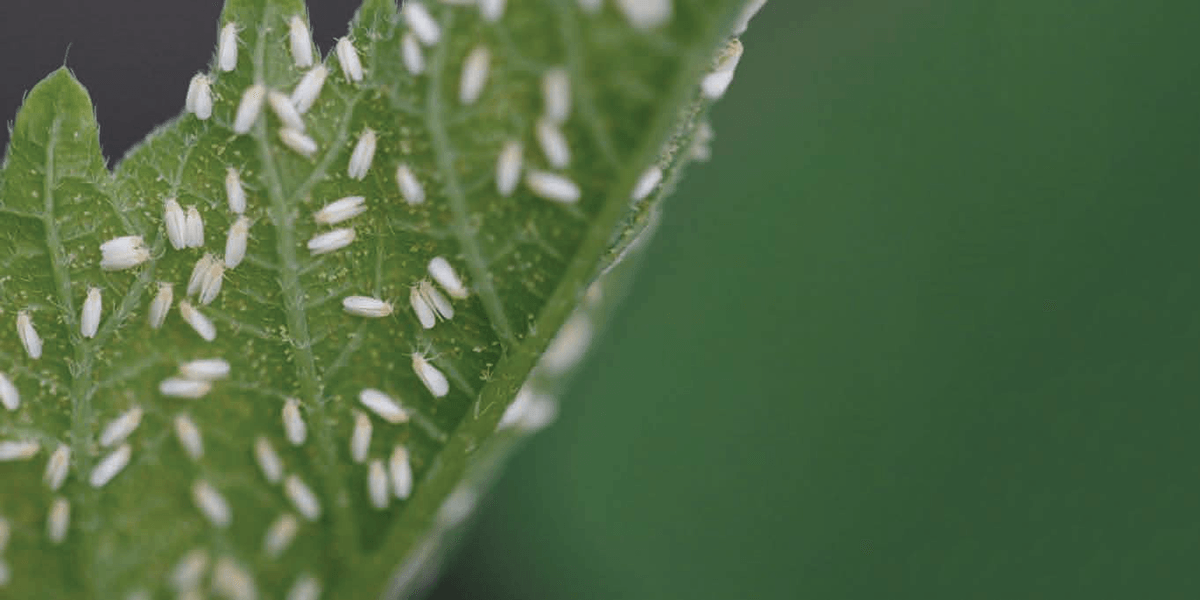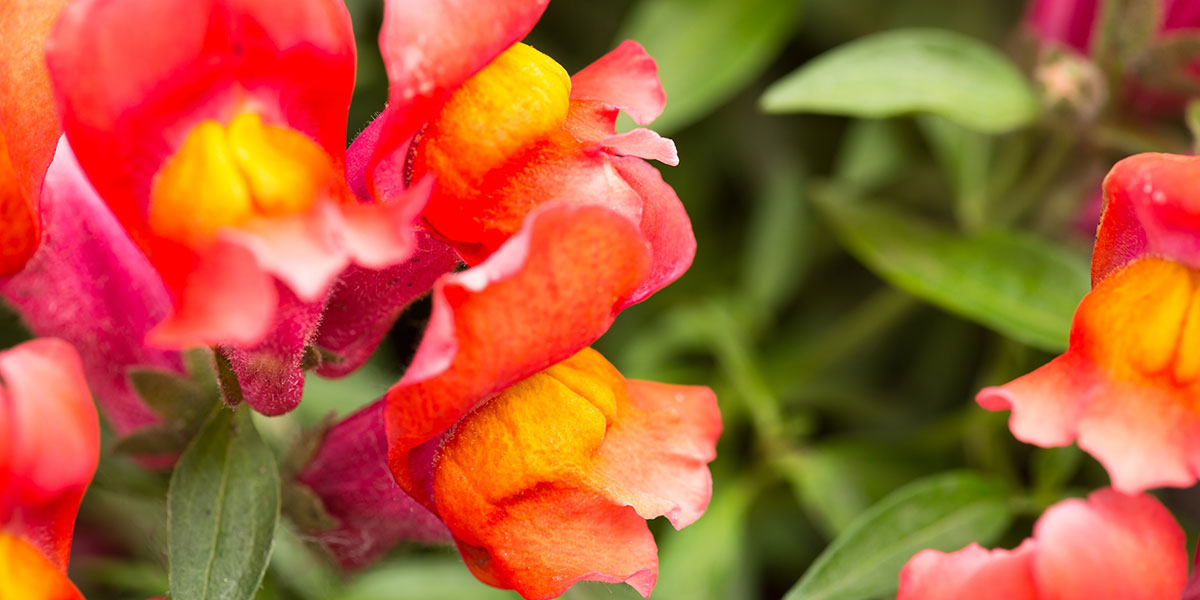______________________________________________________________________________________________________________________________________________________________
It’s Whitefly Time: How to Update Your Rotation Program
By Anna V. Chapman
Battling whiteflies is a constant challenge for growers. Selecting the right products with different modes of action is the first step in winning the battle.
Spring is here. One of the most challenging pests to be on the lookout for this time of year is whiteflies, with sweet potato whitefly (Bemisia tabaci) being the most financially destructive in greenhouse and nursery production. Complicating the efforts to combat sweet potato whitefly is the complexity of biotypes you may encounter and the susceptibility differences of these biotypes to chemical control.
Sweet potato whiteflies frequently travel into greenhouses on infested propagation material or fly in from neighboring agricultural fields and once they have found their way into your ornamental production, there are a number of plant hosts they will infest. Whiteflies feed directly on the phloem or sap of the plant, removing valuable nutrients and water while reducing plant quality and vigor.
Additionally, whiteflies excrete sugary rich honeydew which coats leaves and promotes the growth of sooty mold which further damages the quality of the plant. Both direct feeding damage and sooty mold are exacerbated by the sweet potato whitefly’s potential to reproduce rapidly, which intensifies plant injury.
BATTLING B AND Q BIOTYPES
Most growers are familiar with the two biotypes of sweet potato whitefly; the B and Q biotypes. Although these biotypes look exactly alike, they are distinguishable, most notably to growers, by their response to certain pesticides. Both biotypes were introduced to the United States and quickly became serious pests in both agricultural crops and ornamentals.
The B biotype introduced to the United States in the 1980s is the most commonly encountered type with several effective insecticide tools available for control. However, this species overall does have a tendency for resistance. Rotating the use of effective products will help prevent resistance development in the B biotype and keep chemical tools effective for longer.
The Q biotype introduced in the early 2000s has spread across the country with at least 26 states reporting occurrences, largely within greenhouses. Managing the Q biotype is a greater challenge due to known resistance to several chemical classes which limits the number of insecticides available for treatment. This includes some insect growth regulators, pyrethroids, pymetrozine and the neonicotinoid imidacloprid. The recent pressure on growers to stop the use of neonicotinoid insecticides has resulted in many domestic and overseas growers moving away from effective insecticides to older chemistries. This undoubtedly has contributed to the sweet potato whitefly problem overall and reported failures coming from greenhouses and nurseries across the U.S. and in Canada.
CREATING THE RIGHT ROTATION
For managing both B and Q biotype, the name of the game is keeping population numbers low and breaking the life cycle and reproduction potential of the insect. In a good management program, monitoring and sending off whitefly samples for identification is a great step to help guide your selection of products for rotation and hopefully decrease the number of needed applications to keep sweet potato whitefly under control. The contact information for Cindy Mckenzie’s USDA lab in Florida where samples can be sent to identify biotypes is at the end of this article. Scouting and applying insecticides early before populations have reached damaging levels is best practice. It is easier to control a small infestation, treating when numbers are low. Treating early and maintaining low numbers by repeating applications as needed puts less selective pressure on the population of whiteflies you have present.
WITH A LARGE POPULATION
There is a greater chance of multiple individuals being less susceptible and surviving control measures or, in the case of Q biotype, demonstrating resistance to the applied product.
This could result in a population where we are selecting for harder to control insects and possibly shifting the population towards more Q biotype further limiting the effective chemical options.
To keep population numbers low and reduce your selection pressure for resistance, choose products with different modes of action and create a rotation program that works for you. The Insecticide Resistance Action Committee (IRAC) assigns every insecticide to a mode of action group based on the exact location in an insect where the compound is active, also called the target site. These IRAC group numbers are now listed on the first page of most product labels. Consulting your local extension for recommended products based on activity for sweet potato whitefly and then selecting multiple IRAC group numbers or modes of actions is a good way to begin building a rotation program.
By rotating products, we are exposing insects to different chemical classes as well as acting on different target sites. This variety reduces the selection pressure for less susceptible individuals and helps to prolong the effectiveness of our chemical tools.
It is recommended to use at least three products in your rotation and remember not to apply more than two sequential applications before rotating. There are a number of other considerations to take into account when developing your rotation program.
- When choosing a product, is it labeled for indoor or outdoor use?
- Does the use of neonicotinoid products in the program raise selling
concerns or are they restricted by retailer customers? - Is the product compatible with my biological control insects?
- What is the plant safety and what label restrictions are there?
- If I have multiple crops with whitefly problems this year, what is the
maximal seasonal use rate?
A NEW TOOL
Ventigra® insecticide from BASF offers an additional rotational option for whiteflies. The active ingredient in Ventigra insecticide, afidopyropen, has been classified by IRAC as the only member of the new subgroup 9D. This is a brand new chemical class of which afidopyropen is the only member. Ventigra insecticide is active on both B and Q biotypes making it an excellent new resistance management tool for whiteflies and it has no known cross resistance to key chemical classes such as neonicotinoids and pyrethroids. This insecticide is not only active on whiteflies, but also targets a number of piercing and sucking pests such as aphids, mealybugs and scales. With a favorable environmental profile, it has minimal impact to beneficial insects including predatory mites. Introducing a new active ingredient makes your rotational program more robust, targeting all whitefly biotypes helping to prevent the development of resistance.
Always read and follow label instructions. Ventigra is a registered trademark of BASF.
For identification of B or Q Whitefly from your operation,
a sample can be sent to:
Cindy McKenzie, Ph.D.
U.S. Horticultural Research Laboratory
2001 South Rock Road
Fort Pierce, FL 34945
Telephone: 772.462.5917 | Email: Cindy.McKenzie@ars.usda.gov
Anna V. Chapman is a research scientist at BASF. She can be reached at anna.chapman@basf.com.





